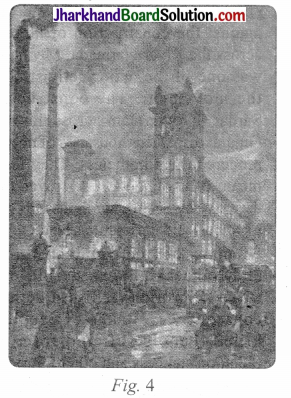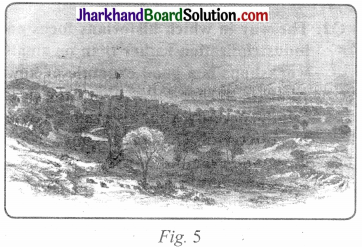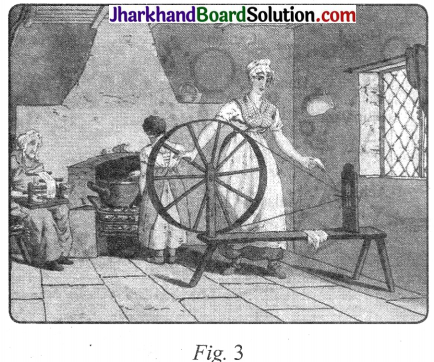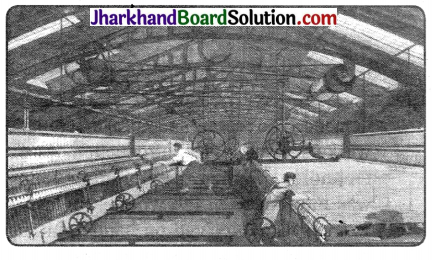JAC Board Class 10th Social Science Important Questions History Chapter 4 The Age of Industrialisation
Multiple Choice Questions
Question 1.
When were the earliest factories in England set up?
(a) 1370s
(b) 1870s
(c) 1760s
(d) 1730s
Answer:
(d) 1730s
Question 2.
Who created the cotton mill in England?
(a) James Watt
(b) Richard Arkwright
(c) Henry Patullo
(d) Seth Hukumchand
Answer:
(b) Richard Arkwright

Question 3.
Who improved the steam engine produced by Newcomen?
(a) James Watt
(b) Richard Arkwright
(c) Mathew Boulton
(d) Dinshaw Petit
Answer:
(a) James Watt
Question 4.
Who devised the Spinning Jenny?
(a) Richard Arkwright
(b) James Watt
(c) James Hargreaves
(d) Newcomen
Answer:
(c) James Hargreaves
Question 5.
In which year was the Spinning Jenny designed?
(a) 1674
(b) 1764
(c) 1746
(d) 1647
Answer:
(b) 1764
Question 6.
Which city on the Gujarat coast connected India to the Gulf and Red Sea ports?
(a) Dwarka
(b) Bhavnagar
(c) Porbandar
(d) Surat
Answer:
(d) Surat
Question 7.
Which town on the Coromandel Coast had trade links with Southeast Asian ports?
(a) Surat
(b) Afghanistan
(c) Persia
(d) Masulipatam
Answer:
(d) Masulipatam
Question 8.
Which town in Bengal had trade links with Southeast Asian ports?
(a) Hoogly
(b) Porbandar
(c) Dwarka
(d) Mas’ulipatnam
Answer:
(a) Hoogly
Question 9.
When was the first cotton mill in Bombay set up?
(a) 1855
(b) 1854
(c) 1862
(d) 1874
Answer:
(b) 1854

Question 10.
In which year was the first jute mill in Bengal set up?
(a) 1854
(b) 1862
(c) 1855
(d) 1874
Answer:
(c) 1855
Very Short Answer Type Questions
Question 1.
What is proto-industrialisation?
Answer:
Even before factories began to dot the landscape in England and Europe, there was a large-scale industrial production for an international market. This was not based on factories. Many historians now refer to this phase of industrialisation as proto-industrialisation.
Question 2.
What were trade guilds?
Answer:
Trade guilds were associations of producers that trained craftspeople, maintained control over production, regulated competition and prices, and restricted the entry of new people into the trade.
Question 3.
Why did London come to be known as a finishing centre?
Answer:
The finishing of textiles was done in London before the export merchant sold the cloth in the international market. Therefore, it came to be known as a finishing centre.
Question 4.
How did inventions in the eighteenth century help in the production process?
Answer:
A series of inventions in the eighteenth century increased the efficacy of each step of the production process (carding, twisting and spinning, and rolling). They enhanced the output per worker, enabling each worker to produce more and they made possible the production of stronger threads and yam.
Question 5.
What were the most dynamic industries of Britain in the early nineteenth century?
Answer:
Cotton and metals were the most dynamic industries of Britain in the early nineteenth century.
Question 6.
What did the historians recognise the typical workers of mid-nineteenth century as?
Answer:
Historians increasingly recognised the typical workers of mid-nineteenth century as traditional craftsperson and labourer and not as a machine operator.
Question 7.
Why did the upper classes in Victorian Britain prefer things produced by hand?
Answer:
Handmade products came to symbolise refinement and class. They were better finished, individually produced, and carefully designed. Therefore, the aristocrats and bourgeoisie of Victorian Britain preferred things produced by hand.

Question 8.
What do you understand by seasonality of work?
Answer:
Seasonality of work in many industries meant prolonged periods without work. After the busy season was over, the poor were jobless again. Few returned to the countryside after the winter, when the demand for labour in the rural areas opened up in places. However, most of them searched for odd jobs, which till the mid-nineteenth century were difficult to find. *
Question 9.
What was Spinning Jenny?
Answer:
Spinning Jenny speeded up the spinning process, and reduced labour demand. By turning one single wheel a worker could set in motion a number of spindles and spin several threads at the same time.
Question 10.
Why did the number of workers employed in the transport industry double in the 1840s?
Answer:
The number of workers employed in the transport industry doubled in the 1840s because after the 1840s, building activity intensified in the cities, opening up greater opportunities of employment. Roads were widened, new railway stations came up, railway lines were extended, and tunnels dug, drainage and sewers laid, and rivers embanked.
Short Answer Type Questions
Question 1.
Why couldn’t the merchants expand their production within towns in the seventeenth and eighteenth centuries?
Answer:
The merchants could not expand their production within towns in the seventeenth and eighteenth centuries because urban crafts and trade guilds were powerful. These were associations of producers that trained craftspeople, maintained control over production, regulated competition and prices, and restricted the entry of new people into the trade. Rulers granted different guilds the monopoly right to produce and trade in specific products. It was therefore, difficult for new merchants to set up business in towns.
Question 2.
How did silk and cotton goods from India dominate the international market in textiles before the age of machine industries?
Answer:
- Coarser cotton was produced in many countries, but India produced the finer varieties.
- Armenian and Persian merchants took the goods from Punjab to Afghanistan, eastern Persia and Central Asia. Bales of fine textiles were carried on camel back via the north-west frontier, through mountain passes and across deserts.
- A vibrant sea trade operated through the main pre-colonial ports. Surat on the Gujarat coast connected India to the Gulf and Red Sea Ports.
- Masulipatam on the Coromandel Coast and Hoogly in Bengal had trade links with Southeast Asian ports.
Question 3.
How were the Indian merchants and bankers involved in the network of export trades?
Answer:
- A variety of Indian merchants and bankers were involved in the network of export trade—financing production, carrying goods and supplying exporters.
- Supply merchants linked the port towns to the inland regions. They gave advances to weavers, procured the woven cloth from weaving villages, and carried the supply to the ports.
- At the port, the big shippers and export merchants had brokers who negotiated the price and bought goods from the supply merchants operating inland.
Question 4.
Why did East India Company face hurdles in the 1760s to ensure a regular supply of goods from India for export?
Answer:
- Before establishing political power in Bengal and Carnatic in the 1760s and 1770s, the East India Company had faced hurdles to ensure a regular supply of goods for export. .
- The French, Dutch, Portuguese and local traders competed in the market to secure woven cloth. The weavers and supply merchants could bargain and tried selling the produce to the best buyer.
- In their letters back to London, Company officials continuously complained of difficulties of supply and the high prices.
Question 5.
What was the new problem that the weavers faced by the 1860s?
Answer:
By the’4 860s, the weavers faced a new problem. They could not get sufficient supply of good quality raw cotton. With the outbreak of American Civil War, cotton supplies from the US were cut off. Britain turned to India for supply. As raw cotton exports from India increased, the price of cotton shot up. Weavers in India were starved of supplies and forced to buy raw cotton at exorbitant prices. In this situation, weaving could not pay.

Question 6.
Explain the growth of factories in India.
Answer:
- The first cotton mill in Bombay came up in 1854 and it went into production two years later.
- By 1862 four mills were at work with 94,000 spindles and 2,150 looms.
- In 1855, the first jute mill came up in Bengal and then seven years later, in 1862.
- In north India, the Elgin Mill was started in Kanpur in the 1860s, and a year later the first cotton mill of Ahmedabad was set up.
- By 1874, the first spinning and weaving mill of Madras began production.
Question 7.
Who were the early entrepreneurs in India? How did they amass capital to invest?
Answer:
- In Bengal, Dwarkanath Tagore made his fortune in the China trade then he turned to industrial investment, setting up six joint-stock companies in the 1830s and 1840s.
- In Bombay, Parsis like Dinshaw Petit and Jamsetjee Nusserwanjee Tata- built huge industrial empires in India. They accumulated their initial wealth partly from exports to China, and partly from raw cotton shipments to England.
- Seth Hukumchand- Marwari businessmen set up the first Indian jute mill in Calcutta in 1917, also traded with China so did the father & grandfather of the famous industrialist G.D. Birla.
- Other trade networks- Some merchants accumulated Capital by trading from Madras with Burma, others had links with the Middle East and East Africa.
Question 8.
Who and how did they control a large sector of Indian industries till the First World War?
Answer:
Till the First World War, European Managing Agencies controlled a large sector of Indian industries. Three biggest ones were Bird Heighlers & Co., Andrew Yule, and Jardine Skinner & Co. These agencies mobilised capital, set up joint- stock companies and managed them. In most instances Indian financers provided the capital while the European Agencies made all investment and business decisions. The European merchant- industrialists had their own chambers of commerce which Indian businessmen were not allowed to join.
Question 9.
Describe the role of a jobber.
Answer:
Industrialists usually employed a jobber f to get new recruits. Very often the jobber was an old and trusted worker. He got people from his village, ensured them jobs, helped them settle in the city and provided them money in times of crisis. The jobber therefore, became a person with some authority and power. He began demanding money and gifts for his favour and controlling the lives of workers.
Question 10.
With the decline of Manchester imports into India, how did the Indian mills gain importance during First World War?
Answer:
With tie British mills occupied with wartime production to meet the requirements of the army, Manchester imports into India declined. Indian mills . suddenly had a vast home market to supply. As the war prolonged, Indian ! factories were called upon to supply war needs, such as jute bags, cloth for army uniforms, tents and leather boots, horse and” mule saddles, and a host of other items. New factories were established and old ones ran multiple shifts. Many new workers were employed and everyone was made to work longer hours. Over the years industrial production boomed.

Question 11.
Why could not the British manufactur¬ers recapture its old position in the In¬dian market after the First World War?
Answer:
After the First World War, Manchester could never recapture its position in the Indian market. It was unable to modernise and compete with the US, Germany and Japan. The economy of Britain crumbled after the war. Cotton production collapsed and exports of cotton cloth from Britain fell dramatically. Within the colonies, local industrialists gradually consolidated their position, substituting foreign manufacturers and capturing the home market.
Question 12.
What did the Manchester industrialists do to sell their cloth in India?
Answer:
When Manchester industrialists started selling their cloth in India, they labelled the cloth bundles. It was done to make the place of manufacture and the name of the company familiar to the buyer. It was also to be a mark of quality. When buyers saw ‘MADE IN MANCHESTER’ written in bold on the label, they were expected to feel confident about buying the cloth.
Long Answer Type Questions
Question 1.
Why in the eighteenth century England, the poor peasants and artisans began working for merchants?
Answer:
- In the countryside, in the eighteenth century England, the poor peasants and artisans began working for the merchants because during this time the open fields were disappearing and commons were being enclosed.
- Earlier the cottagers and poor peasants had depended on common lands for their survival, gathering their firewood, berries, vegetables, hay and straw. Now, they had to search for alternative sources of income.
- Many had tiny plots of land which could not provide work to all members of the household.
- When merchants offered advances to produce goods for them, the peasant households accepted. This enabled them to remain in the countryside and continue to cultivate their small plots.
- Income from proto-industrial production supplemented their shrinking income from cultivation. It also allowed them a fuller use of their family labour resources.
Question 2.
Describe the close relationship that developed between the town and the countryside during the proto-industrial period.
Answer:
- During the proto-industrial period, a close relationship developed between the town and the countryside. Though most of the work was done in the countryside, the merchants were based in towns.
- A merchant clothier in England purchased wool from a wool stapler and carried it to the spinners; the yam (thread) that was spun was taken in subsequent stages of production to weavers, fullers, and then to dyers.
- The finishing was done in London before the export merchant sold the cloth in the international market.
- The proto-industrial system was a part of a network of commercial exchanges.
- It was controlled by merchants and the goods were produced by a vast number of producers working within their family farms, not in factories.
Question 3.
Does industrialisation mean only the growth of factory industries? Discuss.
Answer:
(i) Cotton and metals were the most dynamic industries in Britain. Growing . at a rapid pace, cotton was the leading sector in the first phase of industrialisation up to the 1840s. The demand of iron and steel increased rapidly when there was expansion of railways in England from the 1840s and in the colonies from the 1860s.
(ii) Even at the end of the nineteenth century, less than 20 per cent of the total workforce was employed in technologically advanced industrial sectors. Textiles was a dynamic sector but a large proportion of the output was produced not within factories, but outside, within domestic units.
(iii) Steam-powered cotton or metal industries did not bring about change in the ‘traditional’ industries. But they did not remain stagnant. Ordinary and small innovations were the basis of growth in many non-mechanised sectors, such as food processing, building, pottery, glass work, tanning, furniture making, and production of implements.
(iv) Technological changes did not spread dramatically across the industrial landscape. It was expensive and merchants and industrialists were cautious about using it because repair was costly.

Question 4.
The abundance of labour in the market affected the lives of workers. Explain this with reference to nineteenth century England.
Answer:
The abundance of labour in the market affected the lives of workers in many ways:
(i) The actual possibility of getting a job depended on existing networks of friendship and kin relations. Many jobseekers had to wait for weeks, spend nights under bridges or in night shelters. Some had to stay at Night Refuges that were set up by private individuals; others went to the Casual Wards maintained by the Poor Law authorities.
(ii) Seasonality of work in many industries meant prolonged periods without work. While few returned to the countryside after the winter season when labour was in demand, others looked for odd jobs, which till the mid-nineteenth century was very difficult to find.
(iii) The fear of unemployment made workers hostile to the introduction of new technology.
Question 5.
How did East India Company try to establish control over trade in India?
Answer:
- The European companies gradually gained power first securing a variety of concessions from local courts, then the monopoly rights to trade. This resulted in a decline of the old ports of Surat and Hoogly through which local merchants had operated.
- Exports from these ports fell dramatically, the credit that had financed the earlier trade began drying up, and the local bankers slowly went bankrupt.
- As Surat and Hoogly decayed, Bombay -and Calcutta grew. The shift from the old ports to the new ports indicated the growth of colonial power.
- Trade through the new ports came to be controlled by European companies, and was tarried in European ships.
- While many of the trading houses collapsed, those who wanted to survive had to now operate within a network shaped by ftie European trading companies.
Question 6.
In the twentieth century, handloom cloth production expanded steadily: almost trebling between 1900 and 1940 in India. How did this happen?
Answer:
- Handloom cloth production expanded steadily; almost trebling between 1900 and 1940 partly because of technological . changes.
- Handicrafts people adopted new technology if it helped them improve production without excessively pushing up costs.
- By the second decade of the twentieth century, weavers used looms with a fly shuttle. This increased productivity per worker, speeded up production and reduced labour demand.
- By 1941, over 35 per cent of handlooms in India were fitted with fly shuttles. In regions, such as Travancore, Madras, Mysore, Cochin and Bengal, the proportion was 70 to 80 per cent.
- There were several other small innovations that helped weavers improve their productivity and compete with the mill sector.
Activity Based Questions
Question 1.
Read the clues and solve the crossword puzzle:
Across
- A paid servant called to supervise weavers, collect supplies, and examine the quality of cloth
- An Indian soldier in the service of the British
- The process in which fibres, such as cotton or wool, are prepared prior to spinning
- A person who ‘staples’ or sorts wood according to its fibre
- It is a mechanical device used for weaving, moved by ropes and pullies
![]()
![]()






